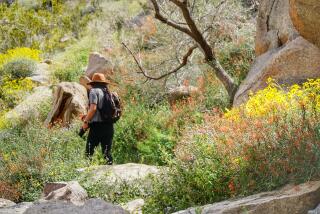WILD CUCUMBER
- Share via
If one hastens, one can still catch a glimpse of the last few prickly blooms of the wild cucumber climbing up over shrubs and sprouting along the ground throughout the Southland.
The blooming period runs from January to June and by midsummer, the plant becomes a mass of tangled leaves and dried stems.
But while the spiny flowers are still visible, the wild cucumber ( Chilicothe ) can be identified by its trailing vine and stalked leaves. The vine emerges from a huge, fleshy root and the leaves measure up to 4 inches across.
Wild cucumbers, which have green stems up to 25 inches long, are among the first plants to sprout after a fire has blackened the earth.
The five-petaled flowers are cream-colored. Female flowers bear large, egg-shaped, bright green fruit about 4 inches long. They are covered with large, soft green prickles that become hard and spiny as the fruit dries.
Male flowers grow in groups of 5 to 20. At the base of the same plant is often a female flower.
Though the plant is called wild cucumber, it is not at all edible. In fact, its bitter juice is poisonous.
The plant also is known as Manroot because the underground tuber, which can weigh up to about 100 pounds, has been said to look like a mummy.
Wild cucumbers are found in chaparral, coastal sage scrub and oak woodland plant communities.






